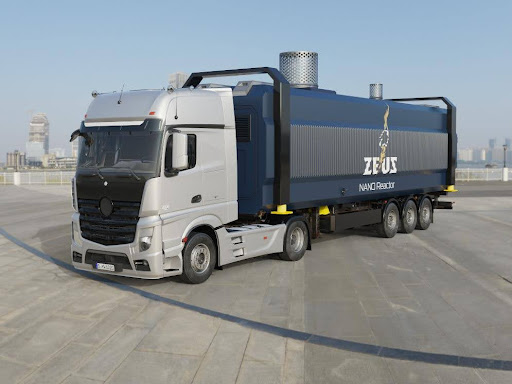Nuclear power is one of the more contentious renewable energy sources. It still divides the United States public and Congress alike. However, we can’t dismiss it as one of the cleanest sources. More private companies are innovating nuclear solutions as the U.S. moves toward decarbonization.
NANO Nuclear Energy Inc., a New York-based reactor developer and consultancy firm founded in 2021, is currently innovating portable, on-demand capable micro-reactors. The ODIN and ZEUS reactors aim to replace traditional power sources in specific regions. They can be delivered via semi-truck to any location and are designed for longevity, with estimated lifecycles up to 20 years before needing a novel uranium source.
According to the company website, ODIN will “utilize conventional fuel form with up to 20% enrichment, helping to minimize the required development and testing program schedule and costs.”
“NANO has planned its business around the identified market, unlike many other microreactor designs that began as academic exercises,” Jay Jiang Yu — founder, executive chairman, and president — and James Walker — CEO and board member — told The Business Download via email. “NANO also made extensive efforts to bring in the best technical people in the world to construct the reactors best suited to realize its ambitions.”

Photo Courtesy NANO Nuclear Inc.
A team of top nuclear scientists works with the company to make these reactors as safe and reliable as possible. Many come from prestigious institutions like the University of Cambridge, University of California, Berkeley, Argonne National Laboratory, and Rolls-Royce.
The goal is to build these reactors for private industries, federal institutions, and conventional power grids alongside several other reactor developers.
The company explained that the ODIN and ZEUS reactors are still being developed. The project is in conjunction with the Idaho National Laboratory, the top federal nuclear energy research and development facility. The goal is to launch the reactors in 2030.
We asked the company leadership if they were facing apprehension from interested parties despite the benefits of this form of energy production. “Interested parties are typically concerned about the regulatory challenges involved with deploying nuclear technologies,” they said. “Fortunately, we are able to demonstrate mechanisms and strategies for navigating these obstacles by hiring former technical and government leaders who understand how to navigate the licensing processes and to engage with the relevant persons to assist with the applications and inquiries we have.”
In October 2023, NANO sponsored S&P Global Commodity Insights’ 25th Annual Financing U.S. Power Conference. Walker was part of a panel discussion on nuclear energy investments. He was among 40 leading executives, thought leaders, and government officials.
The company recently joined the Nuclear Institute, a U.K.-based professional membership body dedicated to the nuclear sector. The Institute provides a safe space for the community to interact, network, and participate in events globally.

Photo Courtesy NANO Nuclear Inc.
In addition to micro-reactor development, NANO started a subsidiary, HALEU Energy Fuel Inc. This company develops high-assay, low-enriched uranium to meet demands for growing nuclear power. The company’s name is the acronym of this metal — high-assay low-enriched uranium.
The goal is to create a domestic supply chain for reactors. Much of this specific uranium is traditionally imported from Russia, the only country with a commercial source. In light of the Russia-Ukraine War, federal funding is allowing HALEU to create this uranium on home soil.
There is more to creating domestic HALEU than phasing out Russian supply. NANO wants three revenue streams: nuclear services and consultancy, fuel fabrication, and reactor deals.
Nuclear power is getting a federal boost thanks to the Inflation Reduction Act. Up to $369 billion in climate provisions are being incentivized under the law. Around $700 million will go toward the domestic supply of HALEU.
World leaders are reckoning with nuclear power. At COP28 in Dubai, countries pledged to triple their nuclear energy generation, but it will take many years and billions of dollars to get to scale. Some countries need new infrastructure, such as updated reactors. However, the benefits outweigh the costs in the eyes of many global advocates.
Jiang Yu told POWER Magazine that nuclear energy is necessary to meet the president’s decarbonization goals. Factors like aging facilities, cheaper power sources like liquefied natural gas, and regulatory red tape are continually the biggest hurdles for more nuclear energy projects.
We could see NANO’s reactors in urban areas as city councils move off fossil fuels but struggle with other renewables like wind, solar, and hydro.
Company representatives expressed optimism about increasing their reach internationally. Japan recently lifted operational bans on Tokyo Electric Power’s Kashiwazaki-Kariwa nuclear plant. The plant was shut down in 2012 following the Fukushima disaster after the 2011 earthquake and tsunami. NANO believes reopening this plant opens opportunities for more scalable micro-reactors.
“Cities, like projects or mines, are not always optimally suited to utilize wind or solar energy, and even when they are, huge tracts of land are required, which require additionally expensive storage facilities, and even then, the capacity factor (consistency of reliance possible) on these energy supplies is a fraction of the consistency and dependability of nuclear power,” the company leadership said.





